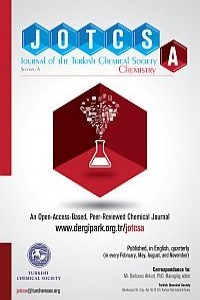PRODUCTION AND CHARACTERIZATION OF ACTIVATED CARBON FROM POMEGRANATE PULP BY PHOSPHORIC ACID
In this study, samples of activated carbon were prepared from pomegranate pulp by chemical activation. H3PO4 was used as chemical activation agent and three impregnation ratios (50-100-200%) by mass were applied on biomass at impregnation times of 24 and 48 hours. Carbonization is applied to impregnated biomass samples under N2 sweeping gas in a fixed bed reactor at 500 and 700 °C. For determination of chemical and physical properties of the obtained activated carbons; elemental analysis was applied to determine the elemental composition (C, H, N, O) and FT-IR spectra was used to analyze the functional groups. BET equation was used to calculate the surface areas of activated carbons. For understanding the changes in the surface structure, activated carbons were conducted to Scanning Electron Microscopy (SEM). Maximum BET surface area (840 m2/g) was reached with the activated carbon generated using 200% H3PO4 impregnated biomass sample, at a carbonization temperature of 700 °C and impregnation time of 48 hours. Experimental results showed that impregnation ratio have a significant effect on the pore structure of activated carbon and pomegranate pulp seems to be an alternative precursor for commercial activated carbon production.
Keywords:
Chemical activation, carbonization, characterization, activated carbon biomass,
___
- Hendawy, A.A.,2006. Variation in the FTIR spectra of a biomass under impregnation, carbonization and oxidation conditions, Journal of Analytical Applied Pyrolysis, 75, 159.
- Ioannidou, O. and Zabaniotou, A., 2007. Agricultural residues as precursors for activated carbon production—a review, Renewable and Sustainable Energy Reviews, 11 ,1966.
- Senthilkumar, T., Chattopadhyay, S.K. and Miranda, L.M., 2017. Optimization of Activated Carbon Preparation from Pomegranate Peel (Punica granatum Peel) Using RSM, Chemical Engineering Communications,204 , 238.
- Başlangıç: 2014
- Yayıncı: Türkiye Kimya Derneği
Sayıdaki Diğer Makaleler
Sevil ÖZKINALI, Muhammet Serdar ÇAVUŞ, Büşra UMUR SAKİN
Veysel U. CELENK, Z. Pinar GUMUS, Zeliha USTUN ARGON, Mevlut BUYUKHELVACIGİL, Ercument KARASULU
Omer Tahir GUNKARA, Nuket OCAL
Metin Yurddaskal, Serdar Yıldırım, Tuncay Dikici, Melis Yurddaskal, Mustafa Erol, İdil Aritman, Erdal Çelik
Yasemin BUDAMA KİLİNC, Rabia CAKİR KOC, Zeynep KAYA
İbrahim OZCESMECİ, İdris SORAR
Masahiro Mikuriya, Chihiro Yamakawa, Kensuke TANABE, Daisuke YOSHİOKA, Ryoji MİTSUHASHİ, Hidekazu TANAKA, Makoto HANDA
Youssef MERROUN, Soukaina CHEHAB, Touriya GHAILANE, Said BOUKHRIS, Rachida GHAILANE, Nouzha HABBADI, Amina HASSIKOU, Brahim LAKHRISSI, Abdelaziz SOUIZI
